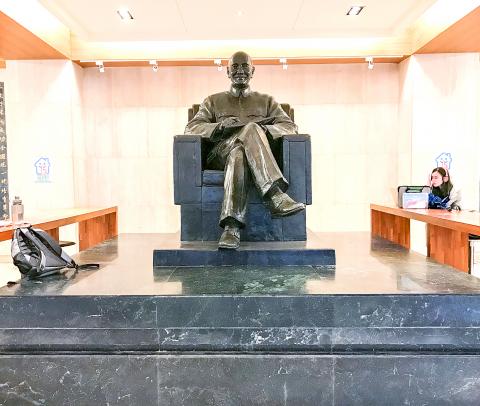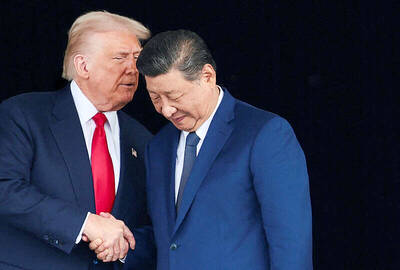National Chengchi University yesterday passed a motion at an administrative affairs meeting that called for statues of Chiang Kai-shek (蔣介石) to be removed as part of efforts to promote human rights and transitional justice.
The decision was in response to protests last year, when students plastered a statue of Chiang with fliers containing the names of people killed in the 228 Incident and called for the statue’s removal.
The university was established in Nanjing, China, in 1927 to train people to serve in the Chinese Nationalist Party (KMT) and was moved to Taiwan when the party fled China.

Photo: Huang Yao-cheng, Taipei Times
Chiang was president of the institution from its establishment until 1947 and was given the honorary title of “perpetual president emeritus.”
Two large bronze statues of Chiang were erected at the university: one in a sitting position in the library and one on horseback at the rear of the school’s campus.
Hsu Tzu-wei (徐子為), head of the university’s graduate students association, said that after last year’s protests by the Wildfire Front student group, university officials repeatedly delayed the removal of the statues.
Opponents said at the meeting that removing the statues would hurt the school’s integrity and international reputation, adding that Chiang’s contributions should be discussed alongside his mistakes.
Removing the statues would be an important first step toward transitional justice, Hsu said, adding that the 228 Incident and the subsequent White Terror era were the direct result of Chiang’s authoritarian rule.
As some of the university’s students are descendants of White Terror victims, honoring Chiang with statues is a second attack on victims’ families, he added.
The four-hour meeting ended with 52 of 68 votes in favor of the statues’ removal, Graduate Institute of Development Studies professor Lee Yeau-tarn (李酉潭) said.
Lee said he would lead a team of seven other professors and three student representatives to discuss how to move forward with relocating the statues to an “appropriate location.”
National Taiwan University history professor Hua Yih-fen (花亦芬) lauded the decision, saying that educators should seek to espouse the values of freedom and democracy, adding that allowing the statues to remain at the university would run counter to those values.
“Fortunately, National Chengchi University was willing to follow sound advice,” she said, adding that transitional justice involves more than just judicial and political elements.
“The removal of the statues honoring Chiang was long overdue,” National Chengchi University associate professor Liu Hung-en (劉宏恩) said.
Regardless of one’s evaluation of Chiang as a political leader, it is absurd to have a president’s statue on campus that is more than three times taller than a person’s height, he said.
If the statues were meant to honor the university’s founder, then every institution should have similar statues, Liu said, adding that the university’s association with a particular party is a source of frustration for many students and professors.
“If it is not a KMT school, why are statues from the period of authoritarian KMT rule kept?” Liu asked.
“What is the reason behind keeping the statue of someone who killed so many people?” asked one student, who declined to be named.

CALL FOR SUPPORT: President William Lai called on lawmakers across party lines to ensure the livelihood of Taiwanese and that national security is protected President William Lai (賴清德) yesterday called for bipartisan support for Taiwan’s investment in self-defense capabilities at the christening and launch of two coast guard vessels at CSBC Corp, Taiwan’s (台灣國際造船) shipyard in Kaohsiung. The Taipei (台北) is the fourth and final ship of the Chiayi-class offshore patrol vessels, and the Siraya (西拉雅) is the Coast Guard Administration’s (CGA) first-ever ocean patrol vessel, the government said. The Taipei is the fourth and final ship of the Chiayi-class offshore patrol vessels with a displacement of about 4,000 tonnes, Lai said. This ship class was ordered as a result of former president Tsai Ing-wen’s (蔡英文) 2018

‘SECRETS’: While saying China would not attack during his presidency, Donald Trump declined to say how Washington would respond if Beijing were to take military action US President Donald Trump said that China would not take military action against Taiwan while he is president, as the Chinese leaders “know the consequences.” Trump made the statement during an interview on CBS’ 60 Minutes program that aired on Sunday, a few days after his meeting with Chinese President Xi Jinping (習近平) in South Korea. “He [Xi] has openly said, and his people have openly said at meetings, ‘we would never do anything while President Trump is president,’ because they know the consequences,” Trump said in the interview. However, he repeatedly declined to say exactly how Washington would respond in

WARFARE: All sectors of society should recognize, unite, and collectively resist and condemn Beijing’s cross-border suppression, MAC Minister Chiu Chui-cheng said The number of Taiwanese detained because of legal affairs by Chinese authorities has tripled this year, as Beijing intensified its intimidation and division of Taiwanese by combining lawfare and cognitive warfare, the Mainland Affairs Council (MAC) said yesterday. MAC Minister Chiu Chui-cheng (邱垂正) made the statement in response to questions by Democratic Progressive Party (DPP) Legislator Puma Shen (沈柏洋) about the government’s response to counter Chinese public opinion warfare, lawfare and psychological warfare. Shen said he is also being investigated by China for promoting “Taiwanese independence.” He was referring to a report published on Tuesday last week by China’s state-run Xinhua news agency,

‘ADDITIONAL CONDITION’: Taiwan will work with like-minded countries to protect its right to participate in next year’s meeting, the foreign ministry said The US will “continue to press China for security arrangements and protocols that safeguard all participants when attending APEC meetings in China,” a US Department of State spokesperson said yesterday, after Beijing suggested that members must adhere to its “one China principle” to participate. “The United States insists on the full and equal participation of all APEC member economies — including Taiwan — consistent with APEC’s guidelines, rules and established practice, as affirmed by China in its offer to host in 2026,” the unnamed spokesperson said in response to media queries about China putting a “one China” principle condition on Taiwan’s